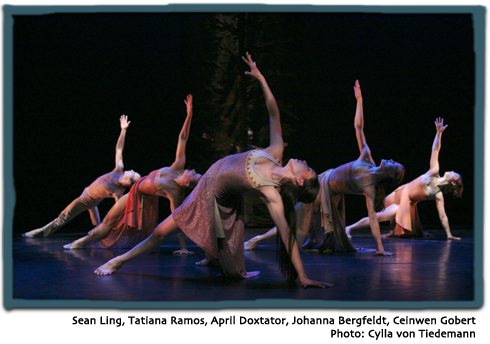 CA: Carol Anderson
CA: Carol Anderson
BS: Santee Smith
Q: Questions and comments
CA: Santee is a woman of many accomplishments. After earning a kinesiology degree, practising as an artist, and participating in the first years of the Aboriginal Dance Program at The Banff Centre, she completed an MA in Dance at York. As part of her MA thesis she created a work called Kaha:wi (She Carries), which was performed at the Premiere Dance Theatre in 2004 (now Fleck Dance Theatre). At the same time, she started her company, Kaha:wi Dance Theatre. Santee is a prolific choreographer and is currently at work on her seventh major choreography, including Kaha:wi, since 2004. She has made several smaller pieces too. Some of you may have seen The Threshing Floor (created and danced by Santee and Michael Greyeyes, who teaches in the York Theatre program) premiered in this studio. A Constellation of Bones is another of Santee's works, along with A Story Before Time, Here on Earth, Tripped Up Blues and A Soldier's Tale. Santee is working internationally, as well as across Canada, and operates out of Canada's National Ballet School.
SS: Yes; while it's not officially a residency, the company is housed there.
I'm going to talk today about how I'm blending, melding, fusing, exploring traditional elements of dance and art, and also about the more contemporary work I'm doing. I'm really bridging those two, and with each work I'm discovering how intersections are made between the traditional and contemporary.
Kaha:wi was my first major work. Because I was doing so much research on my own and in my community, I thought, I'm actually working on a thesis, so I may as well get a degree and make it more formal. That's why I chose to come to York to do my master's degree. My work was in the ethnology stream, a cultural study, because the connection that I have with my work is culturally based.

I'm Mohawk, Turtle Clan from Six Nations. I'm also an artist. I think of myself first as an artist not specifically identifying with culture. As an artist, though, I draw inspiration from my culture, whether in the form of stories or images or belief systems – or sometimes specific steps. We have a very specific repertoire of dance in the Mohawk community, which is based on ceremony, but also on social activity. The ceremonial and the social dance are very similar in their style and steps. The social dances are traditional influences, reflecting my cultural background, my dreams, my vision of who I am. Early on, I decided that I wanted to create dance that is contemporary, a reflection of now, not a replica of traditional dance. It was my goal to create and gather the strength, power and beauty of traditional dance and make it meaningful for me as an artist today, and meaningful to the dancers and other artists with whom I collaborate, and to an audience. I questioned – how can I make my own culture, my own identity meaningful? That perspective is what dance is for me. It has always been so, ever since I was little.
I have a Western-based background in ballet. I spent over fifteen years training professionally in ballet, but always had a latent desire to create work that reflected something about who I was. As I grew into my teens, I wanted to be able to express something that was connected to me as a person and relate it to my culture. I decided to leave the ballet world, but never lost the love and interest for dance. I carried on into academics, and later I was given the opportunity to choreograph a piece for a National Film Board documentary called The Gift, and that sparked everything that has followed. I was to create two dances that reflected some of my cultural background and connection to corn; we have a whole repertoire of song and dance to celebrate corn. Most of those dances are ceremonial, and the director wanted to be able to show, through dance, the meaningful connection to corn that native people across the Americas have. I created two pieces. One was called Three Sisters and the dancers represented corn, beans and squash. The other, Skywoman, based on the Iroquois creation story, represented the woman who fell from the sky. That was in 1996, and since then I've been continuing the journey of connecting to culture and translating and transforming that onto the stage.
As a creator, I view things from the macro to the micro. It always starts for me with a big, expanded vision of the piece. I assemble the team I want to work with, and everything is geared towards this first, big vision; from the very seeds of creation to whatever the final product is, it's always this initial vision that feeds the whole process. There are lots of artistic director/choreographer decisions you have to make to get to the end. My first big project started with such a vision, and Kaha:wi took five years from that initial vision to the end product. That included creating and collaborating on a musical score that melded traditional and contemporary Iroquoian music. I commissioned musicians and singers from my community, since embodying the essence of our musical traditions was important – the sounds, the tone, the sounds in the language, the quality and tempi. All of those defining qualities of Haudenosaunee music I wanted to be able to hear and celebrate, not only just to replicate, but to newly create. I was asking the musicians and song writers to create contemporary songs, inspired by the essence of tradition. That's what we did. We recorded the music and soundtrack simultaneously, and in tandem created the dance.
For me, music and dance are one; it's part of our way of looking at song and dance and community – it's all one. You don't just dance and you don't just sing. It's not compartmentalized in that way. The same is true with theatre, because part of our ceremony is very theatrical. That's how it is in a lot of indigenous communities – music, dance, acting, oration, singing, being an audience member and being a performer happen all in the same event. That's how I like to work as well, conscious at many levels of design elements, the visual images, symbols that are important to the piece I'm doing, or that emerged from the culture. Kaha:wi had all those elements at play, plus trying to capture some of the content, concepts and beliefs of a people in a dance piece. That's where I did a lot of research into the community. Living in the community made it easier, because I grew up learning our stories and going to ceremonies as well. Later, after I left the ballet world, I went back into my community and did ceremonies and learned the dances and songs. I belonged to a singing society, although I have no time for singing any more.

home l shop dcd l history l links l donations l the collection l services l shipping policy l CIDD l exhibitions l CDFTP
educational resources l visits & lectures l making archival donations l grassroots archiving strategy l personnel l RWB alumni


